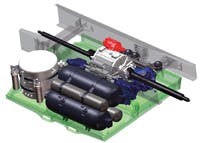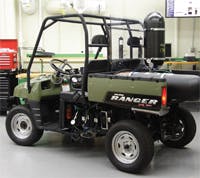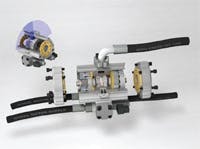As gas prices rise and the green movement grows, more fluid power companies are working to develop hydraulic drivetrains for everything from large trucks to passenger cars and wind turbines. These developments have ranged from complete systems to individual components and ongoing research to complete car manufacturing.
Hydraulic vs. electric hybrids
Although electric hybrids have one major advantage over hydraulics in smaller passenger cars — that being that batteries used for energy storage take up less space than accumulators do — hydraulics has power density and efficient energy storage on its side. And like electric, hydraulics provides regenerative braking, which reduces wear on brakes, so the system reduces fuel consumption and CO2 emissions, as well as maintenance costs.
In addition, says Perry Li, Deputy Director for the National Science Foundation-funded Engineering Research Center for Compact and Efficient Fluid Power (CCEFP) and Professor of Mechanical Engineering at the University of Minnesota, hydraulic accumulators absorb and capture braking energy much more efficiently than electric batteries. “Hydraulic components tend to be more reliable and more costeffective, too,” says Li.
Parker Hannifin’s Vance Zanardelli, Energy Recovery Business Unit Manager, agrees, saying that electric vs. hydraulic performance differences often come down to energy storage capacity vs. power transmission capability. However, says Zanardelli, other considerations boost hydraulics’ position over electric hybrids, including:
• Vehicles with existing onboard hydraulic systems already have a vehicle service infrastructure to accommodate the hydraulic hybrid solution.
• Concerns about battery longevity or disposal favor hydraulic systems.
• High voltage concerns are eliminated.
• The robustness of hydraulics are proven on highduty cycle and off-road applications.
Although others may be working toward developing a hydraulic hybrid drivetrain, following are examples of some currently on the market.
The big three go truckin’
When it comes to the “big three” in fluid power, it’s easy to identify Bosch Rexroth, Parker Hannifin, and Eaton Corp. as three companies clearly involved in hydraulic hybrid designs. All have systems under development, with test systems in place across the country in a variety of large vehicles — refuse trucks, delivery vehicles, and even buses.
There are two major designs for hydraulic hybrid systems under development: series and parallel. Each design offers its own set of advantages. A series system affords simplicity by eliminating most of the traditional drivetrain. The engine drives a hydraulic pump/motor assembly, which transmits power to and from the vehicle’s wheels mechanically. This solution allows running the engine at its most efficient speed, instead of repeatedly accelerating and decelerating. The challenge, says Li, is that all power is transmitted through hydraulic components, so they must be very efficient.
In a parallel system, a hydraulic system serves as an auxiliary drivetrain and supplements a traditional one. This design typically uses the hydraulic drive when frequent stops and starts occur but can be switched over to the traditional drive for highway driving. This design allows only partial engine management, which can limit the potential savings in fuel consumption, says Li.
Bosch Rexroth’s hydrostatic regenerative
braking — Field tests of Bosch Rexroth’s Hydrostatic Regenerative Braking (HRB) parallel hydraulic hybrid system were launched in May by the New York City Department of Sanitation to assess HRB’s viability for use as an alternative drive system for its refuse trucks.
The HRB system uses a hydraulic pump/motor connected to the drivetrain to capture kinetic energy during braking. When braking, the pump/ motor acts as a pump by capturing kinetic energy of the moving vehicle to slow it down and routing (pumping) this energy into a nitrogen-pressurized accumulator. During acceleration, the compressed gas pushes fluid out of the accumulator, and the pump/ motor acts as a hydraulic motor, assisting the engine and reducing the fuel required to accelerate the vehicle. Upon reaching the maximum system speed, the HRB system will disengage, at which point the vehicle will be powered by the engine alone.
Because the vehicle slows down without engaging the conventional brakes as often, the life of the vehicle’s brakes is extended, and the amount of brake dust released into the environment is reduced. According to Michelle DuHadway, manager, Parallel HRB accounts, “On average, the Department of Sanitation replaces brakes approximately once a year, which takes the truck out of service for at least two days. We hope to improve that figure by 50% or more.”
Production for the HRB will start in the third quarter of 2010.
Parker’s series system — Parker introduced the latest version of its RunWise Advanced Series Hybrid Drive system, for use with Class 8 refuse vehicles at WasteExpo in June. RunWise replaces a conventional drivetrain with a series hybrid drive system that marries a hydrostatic drive with a mechanical drive that performs best at highway speeds. Coupling this with brake energy recovery, which captures more than 70% of braking energy, RunWise can reuse this stored energy to accelerate the truck.
RunWise–Modular Gen I features a cradle design, which offers flexibility, accommodates multiple chassis configurations, and simplifies OEM truck assembly with minimal electrical, drive shaft, and cooling system hookups. If service is required, the cradle can be removed and a new cradle reinstalled quickly.
In documented field trials on refuse trucks, the RunWise system has reduced fuel consumption by 30% to 50%, thus reducing CO2 emissions, brake wear, and producing a smoother, quieter ride.
The system is comprised of an engine, primary pump, secondary drive pump and/or motors, accumulators, and Parker’s Power Drive Unit (PDU). A two-speed hydrostatic drive (low speed for 0-25 mph driving and high speed at 26-45 mph) for urban driving is combined with a mechanical direct drive for efficient operation at high speeds (45+ mph). Shifting occurs smoothly and automatically, and all speed modes accommodate brake energy recovery. Braking energy is still recoverable while in direct drive as the primary pump is still connected to the drive-shaft and will work as a pump, applying torque and charging the accumulator.
Parker is also developing simplified series hydraulic hybrid drives for urban delivery vans and port tractors. Its RunWise system is in pre-production with customer and durability validation underway.
Eaton’s parallel hydraulic launch assist —Eaton Corp.’s Hydraulic Launch Assist (HLA) is a parallel system that captures and stores energy that otherwise would be wasted during the vehicle’s normal operation, then uses that energy when needed to reduce fuel consumption.
During deceleration, the HLA system stores energy as pressurized fluid in an accumulator. The stored energy then is fed back to the vehicle during acceleration to reduce the amount of fuel needed to get the truck moving back up to road speed.
Eaton’s HLA system is being tested in Denver on a Peterbilt 320 truck. It will join Eaton’s light-duty and mediumduty hybrids as a commercially available product of the company’s Spencer, Iowa, manufacturing plant in September.
Getting into the driver’s seat
Research is under way in a variety of realms to develop a hydraulic hybrid drivetrain that can be used in a passenger car. Although hydraulics suits vehicles that make frequent starts and stops, thus enabling higher regenerative braking and energy storage, many think a hydraulically powered car is the way to go.
One such group is Lightning Hybrids, Loveland, Colo., which expects to manufacture a fully hydraulic hybrid vehicle by 2010. The company’s LH3 vehicle uses a parallel hybrid system. As reported in our May 2009 issue, the LH3 is expected to deliver 100% improvement in fuel economy because the engine is smaller and more efficient than the engine being replaced, and it can regenerate brake energy at 70% efficiency (compared to 30% regenerative braking efficiency of an electric hybrid system).
The company expects full production of the vehicle by 2012.
Lightning Hybrids’ CEO Dan Johnson said they chose a parallel system because of its flexibility and efficiency. “Because it works in parallel with a conventional drivetrain, there are numerous mechanical configurations which allow the system to greatly improve the efficiency of the standard drivetrain, without ever loading the system more than it otherwise would be,” Johnson said. “Depending on how the electrical controls are arranged, a parallel system can serve to lessen the load on a conventional internal combustion engine at all times. This flexibility allows tuning to increase performance and driveability of the vehicle and eliminate many failure modes that would render the vehicle unable to drive. ”
Industry-academia partnership
Still another hybrid system is under development at the University of Minnesota for the CCEFP, under Li’s guidance. The hybrid drivetrain is one of the CCEFP’s efficiency test beds, says Li, and uses a hydromechanical design.
They chose this architecture because it offers full engine decoupling and independent wheel torque control, says Li. Although the series system offers this as well, it requires much larger pumps and motors. As a result, mechanical efficiency is less dependent on pump/motor efficiency in a hydromechanical design.
Because the use of hybrids for passenger vehicles is often limited by the size of the accumulators, Li says they are also teaming with others within the center to develop lighter, smaller accumulators. The first-generation vehicle uses off-the-shelf components.
Li says the group wants to develop a system for a car the size of a Ford Focus, so the test vehicle is a Polaris Ranger utility vehicle. The goal is to achieve 70 to 100 mpg, with the ability to reach speeds from 0 to 60 mph in 8 sec, with a grade of 8%.
A completely modified drivetrain includes a 20-kW engine, pumps, motors, and composite accumulators — a highpressure one and a low-pressure one that serves as a reservoir. The design provides uninterrupted power flow over the entire speed range of the vehicle.
Getting in on the game
Innas and NOAX, of the Netherlands, introduced the ‘Hydrid,’ a hydraulic serial hybrid drivetrain for passenger cars, off-road equipment, and wind turbines at Hannover Fair. With this design, fuel consumption and CO2 emissions of a vehicle can be more than halved without having to compromise on weight, size, traction, or top speed.
The concept requires extremely efficient hydrostatic pumps, motors, and transformers, based on the company’s Floating Cup pumps and motors. The floating cup pumps and motors reportedly achieve up to 98% efficiency and offer almost no torque losses at low-speed driving or start-up when accelerating from standstill, thus allowing small size motors.
The backbone of the Hydrid is a common pressure rail (CPR) system, which collects and distributes all power inside the vehicle. Accumulators determine system pressure levels, and pressure is controlled by Innas’ hydraulic transformers. Although Innas prefers the design to be used in a series system, a parallel system can also be accommodated.
To read an overview of hybrid designs, click here.
To see videos from Engineering TV on Lightning Hybrids' vehicle, visit Engineering TV.
To see a video from the National Fluid Power Association about hybrid technology, click here.
|
Make contact: |





